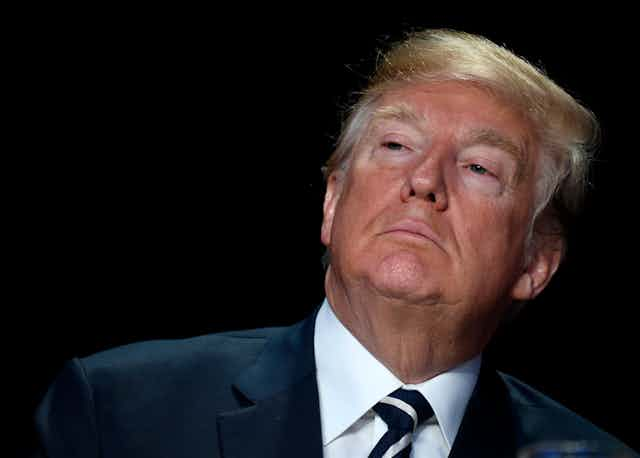When South Korea announced that North Korean athletes would participate in the Winter Olympics alongside its own team, commentators warned that it would take more than sporting camaraderie to reduce tensions on the peninsula.
Students of history – and, in particular, of the Richard Nixon administration – were more optimistic. They remembered a historic parallel: the moment in 1971 when a group of ping-pong players became the first Americans to visit Communist China. Just months later, a shock announcement was made that Nixon would meet with Chinese chairman Mao Zedong.
The announcement of a similar summit between president Donald Trump and Kim Jong-un suggests that reflecting on the US-China relations of the early 1970s can help us understand the latest developments in Korea – and hints at what the future might hold.
Trump and his administration were initially dismissive of Korean cooperation at the Olympics; vice president Mike Pence even refused to stand when the joint Korean team entered the stadium during the opening ceremony. But Pyongyang’s charm offensive stole the show and this popularity may have changed minds in the White House.
Nixon and his foreign policy adviser, Henry Kissinger, had themselves been uneasy about the public’s reaction to a reaching out to Beijing. But Nixon saw the daily front page coverage that the “ping-pong diplomacy” visit garnered and instantly knew that his own trip could be wildly popular. It’s not unthinkable that Trump saw at the Olympics a sign that his famed deal-making might be more popular than his sabre-rattling.
The sabre-rattling may, however, have prefigured this breakthrough. There are profound differences between Nixon and Trump. Nixon was a highly cerebral policymaker, who thought and cared deeply about foreign policy. His briefing papers for his trip to China were not papers – they were books. Trump, in contrast, is largely ignorant about the world. In one blunder, he said that Korea had previously been part of China. He is averse to addressing this ignorance: while Nixon read hundreds if not thousands of pages for one trip, Trump has switched his short daily intelligence digest to an oral briefing.
But there is one major parallel in the approaches of these two presidents: the madman theory.
A meeting of minds
On campaign, Nixon had promised peace with justice in Vietnam. His method to convince Ho Chi Minh to negotiate was to threaten nuclear annihilation. “I want the North Vietnamese to believe I’ve reached the point where I might do anything,” he explained to his chief of staff. “We’ll just slip the word to them that … [you] can’t restrain [Nixon] when he’s angry – and he has his hand on the nuclear button.” Nixon wanted the North Vietnamese – and any other adversaries – to think he was volatile and not to be trifled with.
It may be optimistic to suggest that Trump is consciously employing the madman theory, as Nixon did. Nixon never expected to actually use nuclear weapons in Vietnam. Trump’s bluster of “fire and fury like the world has never seen” may be staged rhetoric, but his tweet ripostes to Kim seem less calculated.
Nonetheless, Kim may be spooked. He and his father have lived safe knowing that no clear-thinking US president would countenance initiating a conflict that would bring 20,000 deaths in Seoul every day. But threats of a “bloody nose” pre-emptive strike seem believable from Trump. Certainly, they have been taken seriously by North Korea’s only foreign sponsor, China.
The long game
What will happen next? It would be the most remarkable development yet if Trump were to follow Nixon’s example and deign to visit North Korea itself. A possible alternative would be another meeting in Beijing, the one country with which both sides have effective relations. Wherever it takes place, the summit will be a success.
The most important moment in Nixon’s visit to China was the first: the US president descended from Air Force One and reached to shake the hand of Zhou Enlai, the Chinese head of state. Televised around the world, that gesture began a new era of rapprochement between the two sides. The mere fact of a Trump-Kim meeting will open a dialogue that will reduce the risk of nuclear war. Trump is an avowed believer in one-on-one talks and his centrality to the negotiations will hold his often-fleeting attention.
But there is reason for caution, too. Nixon’s visit was a spectacular theatrical triumph and transformed the atmospherics of a relationship marred by bloodshed and near-nuclear confrontation. It also helped convince Moscow to cooperate with Nixon’s détente proposals. But it did not resolve the outstanding differences between the US and China.

Nixon wanted Beijing’s help in ending the war in Vietnam, but got none; the Chinese wanted American withdrawal from Taiwan, but the US hesitated. Once the cameras left with Nixon, it took nearly seven more years of hard-fought negotiations before the US and China resolved their disagreements sufficiently to re-establish diplomatic relations.
Most of those painstaking negotiations were conducted by advisers such as Kissinger and by career diplomats. Trump has a threadbare diplomatic staff, including on Korea, and has just fired his secretary of state. A Trump-Kim handshake will be ground-breaking, but addressing the historic differences between the two sides will require perseverance – and Trump is not known for that.

